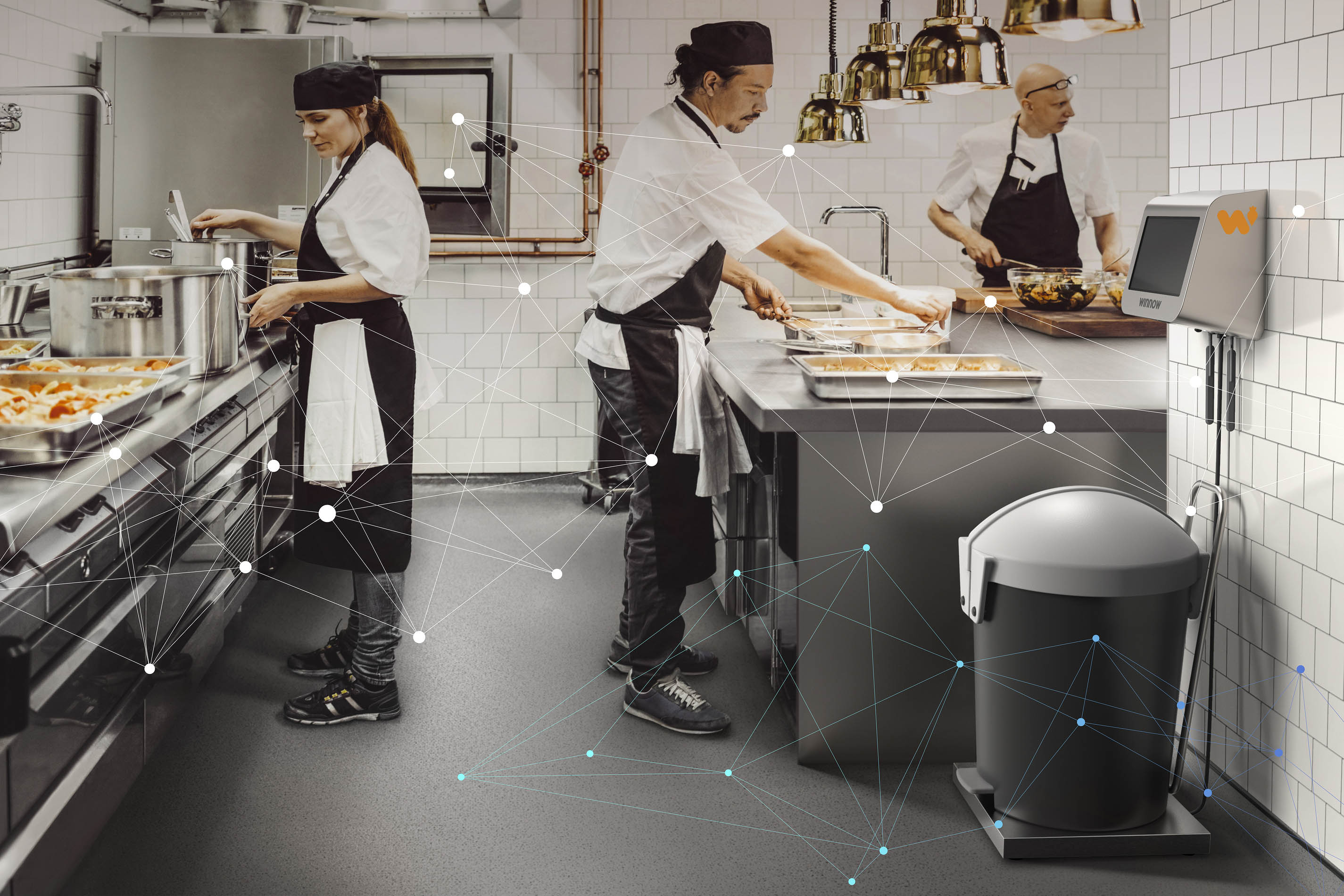
Innovative food waste solutions that help the environment and society
A close look at our food waste problem and the global food waste solutions to address the issue

Jump to a section:
Is food waste really a problem?

Food waste often goes under the radar as a global problem because, for the average person, the reality of the volume of waste is commonly unnoticed.
We do not see the wasted produce that gets left at the farms. And, businesses often conceal the true extent of their waste as they worry it will result in negative news stories. In addition, in our home kitchens, it is time-consuming to track what we throw away. If data is collected, it often does not get analysed.
For many of us, food waste is not really a problem. We have enough to eat and we do not feel the consequences of the issue.
Yet the consequences are, in reality, far more serious. This page will go into the environmental, social, and financial cost of food waste.
The good news is that there are a number of solutions emerging to help us tackle this massive (and growing) global issue. As a planet, we’re on course to throw 66 tonnes of food away each second - it is time for action.
Cutting food waste in half has real bottom-line benefits
Thousands of chefs worldwide are already saving time and money with Winnow
Hospitality kitchens can save between
2-8%
of total food spend
Our clients can reduce food waste and increase profits
See how 3 hotels in Asia have successfully cut waste and increased profitability in their kitchens
Food waste solutions can return up to
1,000%
ROI in year one
Typical ROI 200%-1,000% within the first year of using Winnow
See how IKEA Bergen reduced food waste by 45% over the first 12 weeks
Food waste statistics
Many of the statistics around food waste are so eye-watering that they are difficult to believe. With one-third of all food going to waste every year, there are huge efficiency gains to be made across the food system.
In wealthier countries, particularly in the US and Canada, up to 40% of all food produced goes to waste. In European countries like Germany, as much as $800 million could be saved by preventing food waste.
Wasting food impacts three important but largely separate areas. Food waste causes enormous environmental issues as well as having ethical and financial implications.
How does food waste harm the environment?
If food waste were a country, it would be the third-largest emitter of greenhouse gases after the US and China. This represents around 8% of the entire global greenhouse gas emissions.
This means that bringing effective food waste solutions to market is one of the most important things we can do to combat climate change. In an analysis of the leading climate solutions conducted by Project Drawdown, food waste was ranked as the third most important climate change issue for the world to tackle - ahead of solar power and plant-rich diets.
The costly impact of food waste on climate change is often underestimated. Yet, as more people realise the extent of the damage and the size of the opportunity, an increasing number of solutions have come to market to help solve the problem.
Is there an economic impact on food waste?
The Boston Consulting Group quantifies the cost of food waste: $1 trillion in food waste and loss is lost from our global economy. The picture is projected to worsen, too. By 2030, this figure will likely rise to around $1.2 trillion per annum.
This value is lost throughout the value chain: beginning at our farms and ending up in our homes. Within the hospitality industry, Winnow’s data suggests that food waste represents an average cost of between 8-12% of total food spend. In some instances, this figure can be as high as 20%.
For an industry of typically thin margins, this can be a crucial factor in whether the business operates at a profit or a loss.
How can reducing food waste stop world hunger?
With a growing population that is expected to reach nearly 10 billion by 2050, finding viable food waste solutions is critical for us to feed the world.
Currently, one in nine people goes hungry every day, a figure that has been on the rise in the last three years. However, with ⅓ of all food going to waste, there is enough food to feed the current population, if the food waste issue can be addressed at a global level.
OOf course, reducing food waste is not the only solution necessary to stop world hunger. There are a lot more to be made. Nonetheless, as we begin to fix food waste across the entire supply chain, there will be a considerable amount of food surplus that can make a tangible impact on hunger.
What is the most effective solution to food waste?
There is not a simple or straight answer when it comes to tackling food waste. It is a complex and global problem that faces particular challenges depending on the region of the world.
At Winnow, we believe that the key to reducing food waste in the hospitality industry is through helping chefs in commercial kitchens to track and manage what they are wasting during a typical service. As this can be a manual process if done by hand, technology is a fundamental addition to ensure the change takes place. With the information to hand, chefs average more than a 50% reduction.
In 2019, Winnow launched an artificial intelligence product to automate this process and make it easier than ever to reduce waste in your kitchen. Now live in over 40 countries around the world including the US, Winnow is ready to help large catering companies, cruise ships and hotels to solve their food waste problem.
How effective are digital solutions for hotels?

Large hotel chains such as IHG, AccorHotels, and Hilton have thousands of hotels around the world. Their portfolio is varied, ranging from luxury all-inclusive resorts through to cheaper rooms in urban centres.
To reduce food waste, digital solutions are more effective for larger properties who are serving hundreds or even thousands of meals each day. Larger hotel and resorts can have multiple restaurants across the property, and managing this from an operational perspective can be very challenging.
Digital tools that collect food waste data and re-share it with chefs and the management teams provide detail insights into the efficiency of their operations. It enables them to reduce the weight and the value of the waste in the busiest areas.
This is particularly evident in hotels with one or more buffets each day. How much food is wasted in buffets can be a big opportunity for the hotel industry looking to cut costs.
Thousands of dollars of food can be left on the buffet uneaten, so optimising this area of the business can be very beneficial. This can be particularly true in regions like Asia and the Middle East where extravagant buffets are part of the culture and hotel experience.
Marriott is one example of a hotel giant at the forefront of using digital tools in their hotels. Their ambition to reduce waste is part of their ‘Serve 360’ sustainability initiative. At one of their flagship properties with over 700 rooms, the Grosvenor House Dubai managed to reduce waste by 72%, saving 50,000 meals in the process.

Food waste in America: solutions to tackle the highest wasting country
As one of the richest country in the world with massive financial resources, In the USA, it has become an expectation that food of every type is available all the time. As a consequence of this culture of abundance, food waste has risen dramatically in the country. There is an uncomfortable truth about food waste in the USA - Americans waste a staggering 150,000 tonnes of food each day, equal to a pound per person.
The United States Department of Agriculture (USDA) and EPA are in support of cutting waste in half by 2030, but what are some of the leading ideas in the US to help achieve this target?
-
At the retail level, there are two key areas that will drive significant impact in reducing waste. The first is that it has to be mass adoption of fruit and vegetables that were not considered cosmetically beautiful enough for exacting retailer standards. One such example is the US is Misfits Market which provides imperfect food at 40% reduction at retail price. If more customers chose to do this, the retail giants would relax their standards and significantly reduce the food at the farm level.
-
Another American company that could drastically reduce food waste is Apeel Sciences. Apeel adds natural, edible coatings to food that ‘seals’ the product, ensuring that the moisture inside the food is separated from the oxygen in the air. By preventing over-ripening from happening too fast, perishable food can stay good for a lot longer. For example, strawberries that would ordinarily go mouldy by day 5 are still good to eat. Similarly, lemons can still stay good for 7 weeks or more. This solution has huge potential in reducing waste in our supermarkets and in our homes.
-
The final solution is not a solution to implement every day, but there needs to be more education around the challenges of food waste in the US. With a better understanding of the scale and damage of the problem, people can make better purchasing decisions and waste less food in their homes. Smart packaging and smart labelling will support this education process by giving consumers better information on when a product is actually good to eat or not, but some of these solutions are not ready to deploy at scale.

However, it is not only the USA that struggles to control its food waste and require solutions to solve the problem. Indonesia throws away enough food each year to feed 28 million people - more than 10% of the total population.
Indonesia has a thriving tourism industry that is spread across the country. In 2016 over 12 million tourists visited the country, an increase of over 15% from the year before.
This growth in tourism is supported by a growing population. In the last 60 years, Indonesia’s population has almost tripled.
This combination of tourist and population growth presents a challenge for Indonesia to feed this growing number of people efficiently.
One good example of reducing food waste effectively is from Club Med Bali. The team there saved almost 70,000 meals in only 6 months by using Winnow’s digital tools.
How we've helped clients reduce food waste in their industry
Winnow is the leading food management solution for the contract catering, hotels & casinos, quick service restaurant, supermarket, and cruise ship sectors. Find out how we've helped our clients.
Frequently Asked Questions
Is composting a good solution for dealing with the food waste crisis?


Composting is one way to dispose of wasted food. However, it does not address any of the root causes of the problem and will not help to rectify any of the financial or social issues related to food waste.
The best solution to dealing with the food waste issue is to reduce it in the first instance. Addressing the problem at the source provides the best opportunity to make the biggest impact on the problem.
How quickly can food waste solutions work?


With insightful waste information in the hands of the right people, waste reduction can happen fast. Within the first three months of installation, food waste technology can pinpoint the areas to target first and begin making significant reductions. Once the quick wins have been achieved, the next stage is for the data to identify areas of further optimisation before the waste level stabilises. On average clients reduced waste by over 50% in the first year.
How much do food waste solutions cost?


The cost of a food waste solution like Winnow depends on the size of your food operation. Factors such as the number of systems and the type of hardware required to suit your kitchen(s) are a couple of factors that need to be assessed.
To find out what this will look like for your organisation, book a pricing discussion with a food waste expert today.
How much could I save by using a food waste solution like Winnow?


Winnow’s data shows that on average kitchens waste between 4%-12% of all food purchased. Kitchens using Winnow’s analytics can expect to cut this in half in 6-12 months. This equates to an average saving of between $5k a year for a smaller site through to $50k+ for a large hotel or staff restaurant.



